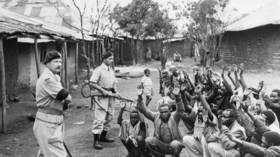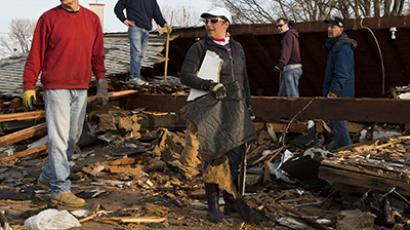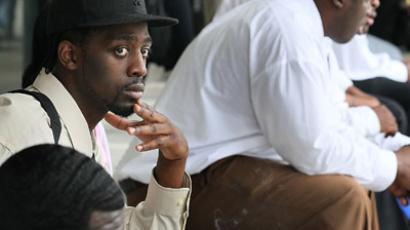Mass shootings prompt millions for additional police officers at schools nationwide

The US Department of Justice has pledged $44mn in grants to provide 356 school resource officers to 141 cities and counties nationwide in what it calls an effort to make schools safer following events like the Newtown, Connecticut, shooting in December.
Grants intended to fund more police officers in schools will go
to law enforcement agencies across the country, the Justice
Department (DOJ) said Friday as it unveiled the entire list of
recipients.
In Modesto, Calif., for example, the city school district will
receive $1mln to fund eight new school resource officers.
Though spending details for the program are not yet available, in
Modesto the City Council will have to approve the program, which
requires grantees to match award totals two-to-one.
“Not only do they deter crime, but they provide opportunities
for positive relations between students and law enforcement,”
Karen Servas, a Modesto City School District grant writer who
worked with the city police department to appeal for funding,
told McClatchy.
Yet many critics say more armed police officers in schools is no
guarantee for a safer environment, and will likely contribute to
worsen the “school-to-prison pipeline” that groups like
the American Civil Liberties Union (ACLU) say disproportionately
targets youth of color and youth with
disabilities.
The “school-to-prison pipeline” operates directly and
indirectly, the ACLU writes in its research on punitive school
discipline.
“Directly, schools send their students into the Pipeline
through zero tolerance policies, and involving the police in
minor discipline incidents. All too often school rules are
enforced through metal detectors, pat-downs and frisks, arrests,
and referrals to the juvenile justice system. And schools
pressured to raise graduation and testing numbers can sometimes
artificially achieve this by pushing out low-performing students
into GED programs and the juvenile justice system.
“Indirectly, schools push students towards the criminal justice
system by excluding them from the learning environment and
isolating them from their peer groups through suspension,
expulsion, ineffective retention policies, transfers, and
high-stakes testing requirements.”
Marc Schindler, director of the Justice Policy Institute which
seeks to reduce mass incarceration, believes the policy is
misguided.
“There is no indication that the presence of (resource
officers) makes schools safer,” Schindler said to McClatchy.
“In fact, there’s research supporting that there’s likely
unwanted consequences.”
The institute published a 2012 report entitled 'The Case
Against Police in Schools,' which shows schools with officers
make more arrests for minor offenses, among other issues.
“In terms of safe schools, research favors a supporting and
nurturing environment based around counselors, social workers and
teachers, which makes kids feel that they’re in a safe
place,” Schindler said. “Because of rare but high-profile
tragedies like Newtown, many are concerned about school safety. I
have kids in school and I want them to be safe. … Unfortunately,
things that sound good are not always the best response.”
The grants are part of Obama administration efforts to secure
schools in the wake of shootings such as the December 2012
massacre at Sandy Hook Elementary School in
Newtown, where 26 people, mostly small children, were shot and
killed by a gunman who took his own life upon arrival of police
at the scene.
Shortly after Sandy Hook, the administration launched a campaign
to reduce nationwide gun violence, proposing more background
checks for those who seek to buy guns and bans on high-capacity
magazines. It also said it wants 1,000 total new school resource
officers and counselors, as well as emergency management plans in
all public schools. Yet, most efforts outside of adding armed
police officers in schools have been brushed aside by Congress.
Resource officers are sworn law enforcement officers with the
authority to make arrests and carry a weapon in schools.
The National Association of School Resource Officers says there
are more than 10,000 resource officers in the US, and that
school-based policing is the fastest growing area of law
enforcement in the nation.
The Obama administration plans mirror those called for by the
National Rifle Association (NRA) shortly after the Sandy Hook
shooting.
"I call on Congress today to act immediately, to appropriate
whatever is necessary to put armed police officers in every
school — and to do it now,” NRA Executive Vice President
Wayne LaPierre said in December.
The NRA softened its tone slightly following an April
organizational review of the Sandy Hook shooting, which called for state legislatures to allow more
school personnel to carry weapons on school grounds after
receiving 40 to 60 hours of training.
The grant money - the DOJ pledged $125mn total, $44mn going
to the officer program - comes from the existing Department of
Justice Office of Community Oriented Policing Services (COPS)
program.
“In the wake of past tragedies, it’s clear that we need to be
willing to take all possible steps to ensure that our kids are
safe when they go to school,” Attorney General Eric Holder
said of the grants in a statement. “These critical investments
represent the Justice Department’s latest effort to strengthen
key law enforcement capabilities and to provide communities with
the resources they need to protect our young people. Especially
in a time of increased challenges and limited budgets, our top
priority must always be the safety and well-being of our
children.”














